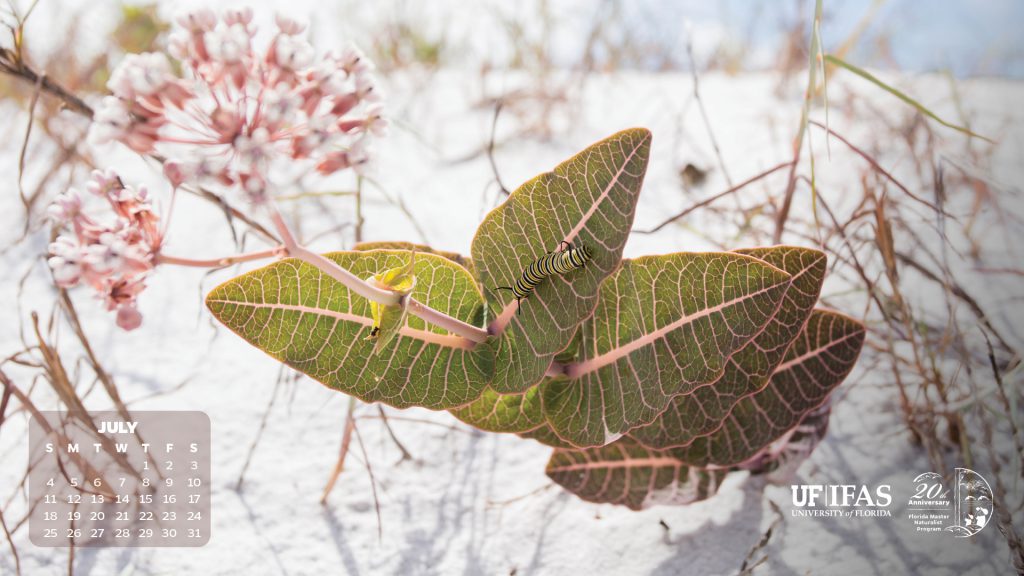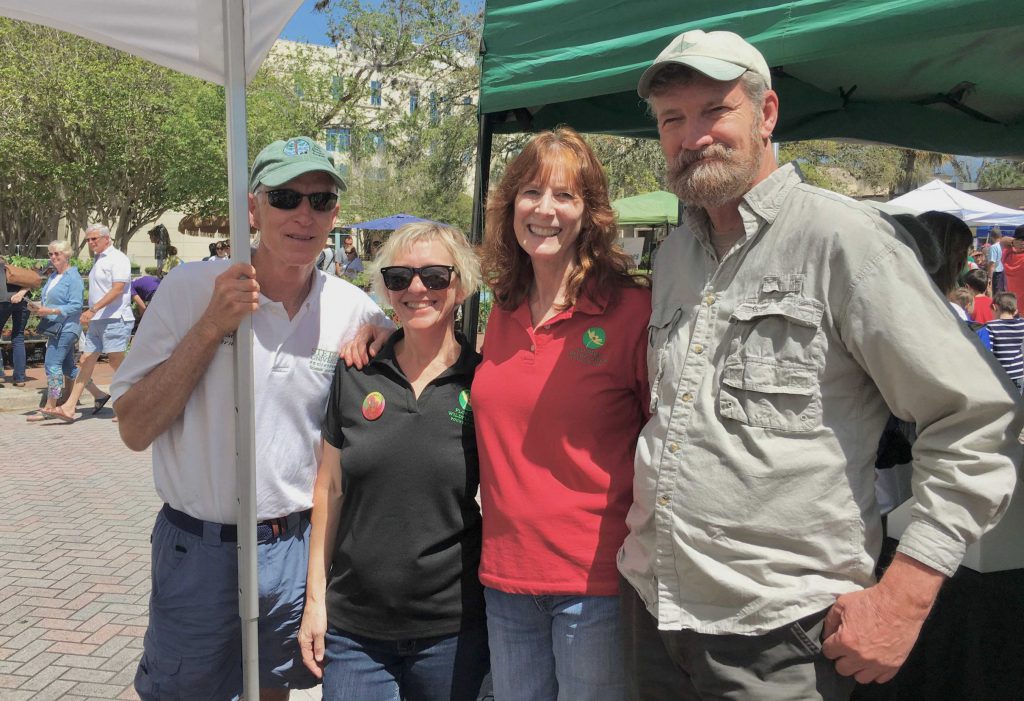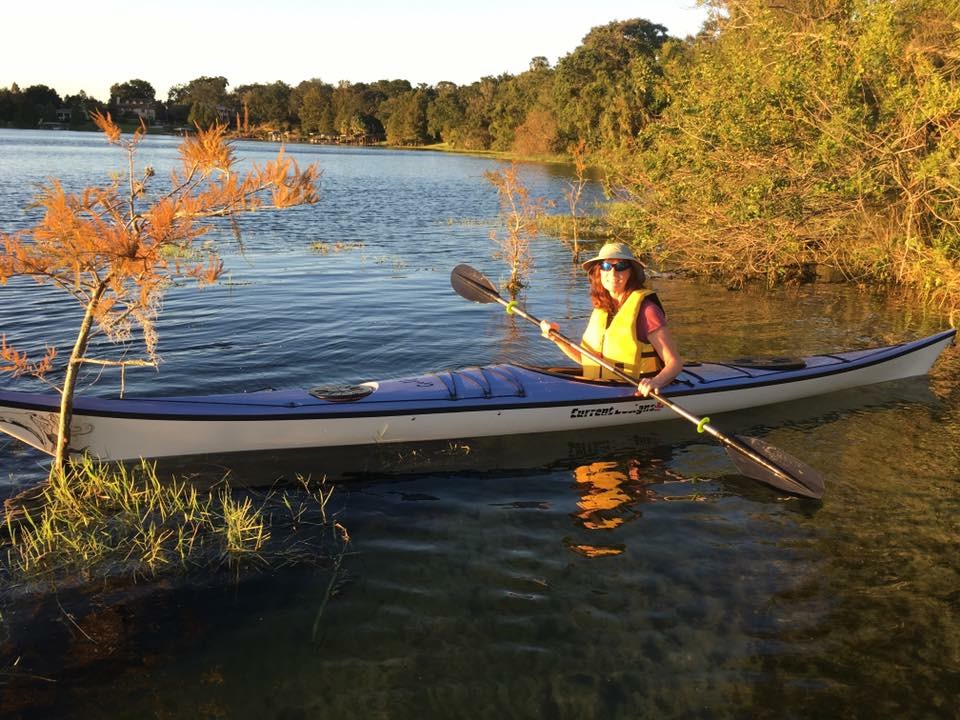We’re highlighting all things Florida Master Naturalist Program (FMNP) in 2021 as the program marks its 20th anniversary. To learn more about FMNP, view the first blog post here.

This month, we’ve interviewed an exceptional Florida Master Naturalist, Lisa Roberts. A Florida native, Lisa serves as the executive director of the Florida Wildflower Foundation where she has done incredible work protecting Florida’s resources.
Hi, Lisa. Thanks so much for joining us! Tell us about your background.
I’m proud to be a lifelong Central Floridian. As a child, I was fortunate to have parents who loved the outdoors. They had a houseboat, and I spent many a weekend with my brothers and sister exploring and fishing on the middle St. Johns River and its tributaries. When he could, my dad would beach the boat somewhere, and we’d set out to explore. At home, we had free rein to roam our neighborhood and its adjoining orange groves, lakes and wetlands. I also experienced a lot of natural Florida from the backs of my horses. Our day-long trail rides often would cross the Econlockhatchee River east of Orlando and traverse pine flatwoods, scrub and oak hammock ecosystems. Sometimes we would swim the horses in a spring-fed lake near the University of Central Florida. All that play in Florida’s great outdoors gave me a great appreciation for nature and its diverse ecosystems, wildlife and plants.

Career-wise, I was a writer and editor at the Orlando Sentinel for more than three decades (I started in my teens!). As travel editor, I’d often write about my outdoor adventures and trips, including those in Florida. Later, as a senior writer, I would pitch stories that would take me outdoors – like the time I covered three women hiking the entire Florida Trail. I spent a day in downpours with them and came home soggy and cold, but with a big smile on my face.
After leaving the Sentinel in 2007, I founded a communications firm. The Florida Wildflower Foundation became one of my clients in 2008. Before I knew it, I was closing my business to become its first full-time executive director.
I love being outdoors whenever possible. I enjoy hiking, kayaking, boating, gardening with native wildflowers and plants, and oil painting en plein air wherever I find Florida’s natural beauty.
How did you get involved with the Master Naturalist Program? When and where did you take FMNP courses?
A friend had told me about the courses, which I really wanted to take. But it wasn’t until I owned my own company that I could finagle the time needed to take them. I took the three core courses in 2008 and 2009 at the UF/IFAS Extension Volusia County office in DeLand. David Griffis, who at the time was the Extension director and a soil scientist, was our instructor. Boy, did I learn a lot about dirt! He never missed a chance to break out his auger. Randy Sleister, a biologist with Volusia County Land Acquisition and Management, assisted along with Linda Evans, Master Gardener coordinator. We certainly had the dream team of Master Naturalist instructors! Not only did they know everything, they made things fun.
I had a terrific time, learned so much and made several good friends, including David, who still volunteers at the annual Florida Wildflower and Garden Festival in DeLand. My favorite module was Coastal – we learned to cast a net at Ponce Inlet in Daytona Beach, paddled Callalisa Creek in New Smyrna Beach, and pretty much hijacked the Extension van in order to score ice cream on the way home from Marineland, where we learned about Sea Grant projects.

Not only are you a Master Naturalist, but you are the Executive Director of the Florida Wildflower Foundation. Tell us about the organization and your work there.
The Foundation is the only organization in the state that protects, connects and expands Florida native wildflower habitat. We are devoted to teaching and demonstrating the important roles wildflowers play in healthy ecosystems and their ties to our own health.
We work statewide to establish “habitat highways” of wildflowers to help pollinators move through urban areas and along roads to reach food crops, managed forests and natural ecosystems.
Outreach and education is the largest slice of our pie. Our website, FlaWildflowers.org, is the world’s best source of Florida native wildflower information. You can learn about different species, download publications, apply for grants and find out how to join or form a local alliance of volunteers to protect roadside wildflowers. We are also very active on Facebook, Instagram and Twitter, and have a great selection of videos at YouTube.com/flawildflowers.
Our planting and conservation program consists of grants for wildflower demonstration landscapes and school gardens. We also teach people to conserve roadside wildflowers through requests for reduced mowing. The Florida Department of Transportation is our closest partner in this effort. Through reduced mowing, the department saves about $1,000 per mile per year in maintenance costs. In Santa Rosa County alone, this effort has saved 700 miles of roadside wildflowers and $70,000 annually.
Finally, our research program annually supports a University of Florida student studying native wildflowers. We conduct our own research projects, too. Currently, we are surveying roadside vegetation in North and Central Florida to find wildflower habitat. Once located, we write management plans that allow it to grow and flourish. We are also studying how to control the weed seed bank when establishing large wildflower plots from seed. In partnership with Lake County, we’ve established four weed seed bank test plots at Palatlakaha Environmental and Agricultural Reserve (PEAR) Park in Tavares and are applying different establishment treatments, including soil inversion.
You’ve accomplished so much with the Florida Wildflower Foundation and reached so many people! Can you tell us about your favorite project or initiative?

My journalist past is probably why I love developing publications like our “20 Easy-to-Grow Wildflowers” magazine. We have many helpful handouts and brochures, too, such as individual publications about wildflowers for birds, bees and butterflies. Our “Wild About Wildflowers! Activity Guide” is filled with lessons and activities for classrooms. Teachers can use individual activities or teach whole units. We’ve had requests from educators all over the United States to download it. Of course, in all of our publications, we lobby heavily for the use of native wildflowers and plants in landscapes.
But I’m also a real research geek. I love working with the people we do – botanists, horticulturists, native plant growers, biologists – because knowledge rubs off. I’m fascinated by what I learn, and the more I learn, the more I want to know.
How has the FMNP impacted you? Does your FMNP training play a role in your position as Executive Director?
The FMNP courses provided the underlying bedrock I needed to fully understand Florida’s ecosystems and what makes them tick. They were a springboard into the deeper, more detailed conservation topics I weave through each day. I am constantly drawing on what I learned in the courses.
Florida is facing a number of different environmental challenges. Where do you think Master Naturalists could make the most difference? What work would you like to see the next generation of Master Naturalists address?
Florida faces profound challenges – from sea level rise due to climate change to the loss of natural lands from development. Master Naturalists have all the tools needed to effectively educate and advocate for actions needed to counter these challenges.
By taking opportunities to educate residents and local, state and federal lawmakers, Master Naturalists can make a difference. In the days to come, our voices will be more important than ever in influencing policy that protects land and water resources.
Do you have any advice for current or future Master Naturalists?
We are trained to interpret and educate. Talk to anyone who will listen about Florida’s unique natural lands, waters and creatures. Get involved and help to create opportunities that let people experience natural Florida first-hand. Only through personal experiences will people begin to connect and care.
And don’t wait – take as many Master Naturalists courses as possible and share your knowledge widely by volunteering for conservation organizations. Florida needs you now.

Where can Master Naturalists learn more about the Florida Wildflower Foundation and how can we help?
Visit FlaWildflowers.org to learn more about our work for Florida’s native wildflowers and the wildlife depending on them. Get involved – if your county doesn’t yet have a Wildflower Resolution to protect roadside wildflowers, round up some Master Naturalist friends and work to get one in place.
The Florida Wildflower Foundation is a non-profit organization solely supported by donations. Our largest funding source is donations generated through the State Wildflower license plate. Each time the plate is purchased or renewed, our Foundation receives a $15 donation for education, planting and research. If you want to contribute to our efforts, the plate helps immensely … and it’s beautiful! You also can make a one-time donation or become a member on our website. Additionally, we offer opportunities to serve on the board of directors or on one of our committees. It does take a village!
 0
0
